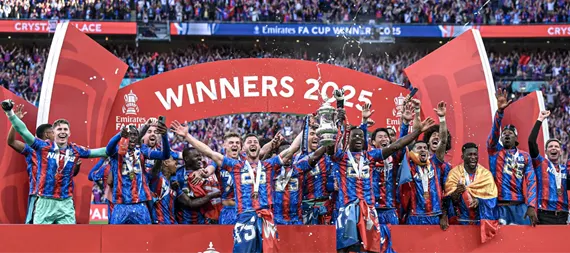There’s something deeply satisfying about watching a football club defy every expectation, every financial projection, every pundit’s prediction. Crystal Palace, under Oliver Glasner, aren’t just enjoying a good run- they’re operating on a different plane entirely. Eighteen games unbeaten. Two major trophies in the cabinet. The best form in Europe, surpassing the likes of Dortmund and Barcelona. And they’re doing it with a fraction of the resources their rivals command.
This isn’t Leicester’s miracle season redux, where lightning struck once and vanished. This is something more sustainable, more tactical, more fascinating. Glasner has built a machine at Selhurst Park that chews up opposition teams regardless of their pedigree- Liverpool, Chelsea, Aston Villa, Manchester City, Arsenal, Tottenham, all have fallen victim to Palace’s relentless efficiency.
But here’s what makes it truly compelling: they’re achieving this dominance while being one of the Premier League’s lowest possession sides. Second-lowest this season, fourth-lowest last campaign. The traditional wisdom suggests teams without the ball can’t control games, yet Palace are systematically dismantling that theory every weekend.
The 3-4-2-1 That Breaks the Mold
Glasner’s preferred formation is the 3-4-2-1, though reducing his system to mere numbers on a tactics board misses the point entirely.
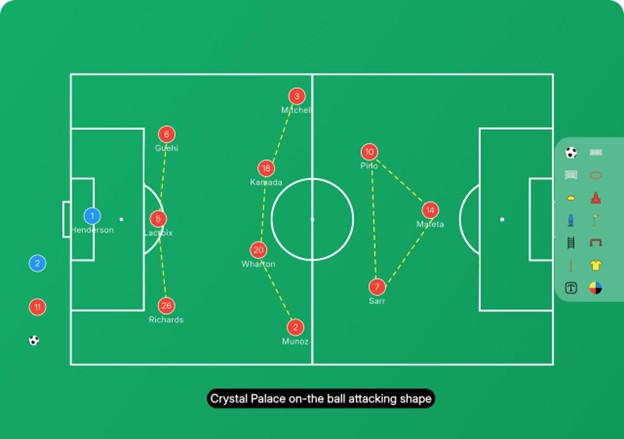
Forget about the formation…simply be the most attack-minded side in the Premier League.
That attack-minded mentality manifests in ways that defy conventional categorisation. Palace don’t sit deep and counter-attack like Nottingham Forest did last season. They’re not parking the bus and hoping for scraps. Instead, they’ve mastered something far more dangerous: direct speed.
Opta currently has Palace as the league leaders for direct speed, a metric that measures how quickly a team moves the ball forward during attacks. It’s calculated by dividing the distance the ball travels by the time spent attacking, and Palace are getting the ball upfield faster than anyone else in the division.
Think about that for a moment. They don’t see much of the ball, yet when they get it, they’re progressing toward goal with ruthless efficiency. Crystal Palace averages an attempt on goal for every eleven passes completed. Manchester City averages a shot every fifty-six passes. Arsenal every fifty-eight. Wolves every sixty. Palace are operating at a completely different tempo, with minimal touches and maximum threat.
Defensive Organisation as an Offensive Weapon
What separates Palace from other direct teams is their defensive structure. When opponents have possession, Glasner’s side doesn’t rely on individual pressing or high-risk challenges. Instead, they move as a single organism, shuffling across the pitch with choreographed precision.
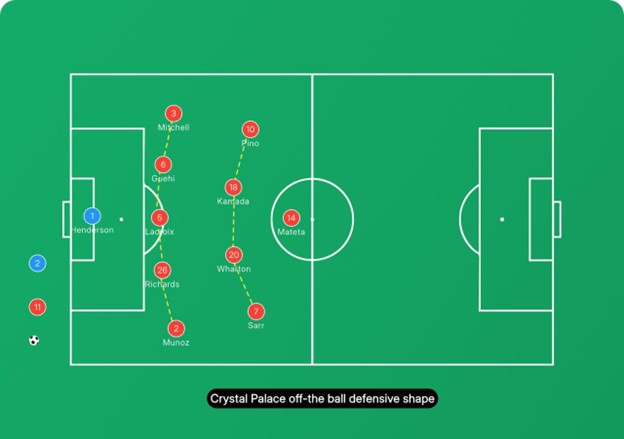
Consider a recent sequence against Liverpool: Mohamed Salah receives the ball wide, seemingly in space. Rather than committing a defender to a one-on-one duel, Salah would likely win; Palace’s entire defensive shape shifts laterally. Tyrick Mitchell abandons his immediate opponent to cut off the passing lane. Marc Guehi leaves his marking responsibility to cover the space Mitchell vacated. The whole unit compresses, eliminates options, and forces Liverpool into exactly the trap Palace have set.
The organisation was so good, the timing so precise, that Mitchell beat Bradley to the ball and intercepted. This isn’t lucky defending or individual brilliance; it’s systematic excellence.
When that interception happens, Palace don’t pause to regroup or recycle possession. They explode forward immediately, with both numbers and pace, catching opponents in transition before they can reorganise. It’s breathtaking in its simplicity and devastating in its execution.
The Numbers Behind the Dominance
The Palace’s statistical profile reads like a contradiction that shouldn’t work but somehow does. They have the joint-highest number of shots on goal with Liverpool and the third-highest expected goals (xG) in the league. Yet their actual goal tally underperforms those chances, evidence that with slightly better finishing, they’d be even more dominant.
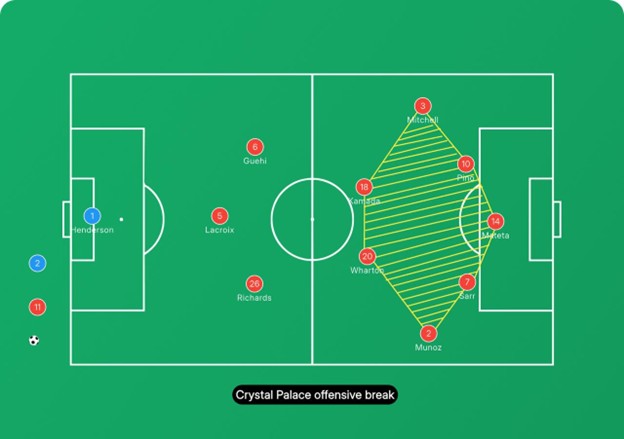
Their carry statistics are equally revealing. Despite their direct approach, Palace rank among the lowest in the league for final third carries and penalty area entries through dribbling. They’re not relying on individual ball-carriers to beat multiple defenders. Instead, they’re using quick, incisive passing combinations and coordinated off-ball movement to slice through defensive lines.
Always forwards on the ball and big coordinated efforts off the ball that are just proving too much for pretty much every team they come up against.
When Palace shift defensively into their 5-4-1 shape, they’re not passively absorbing pressure; they’re actively setting traps, waiting for opponents to commit numbers forward, then pouncing with devastating counter-attacks. It’s patient aggression, if such a thing exists.
The Ingredients of Success
Glasner has achieved something remarkable: he’s convinced an entire squad to sacrifice individual glory for collective efficiency. Full-backs become auxiliary centre-backs when defending switches of play. Centre-backs push high to compress space. Midfielders make lung-busting runs knowing the ball might not arrive. Forwards press with intensity even when exhausted.
It’s pure front-to-back efficiency. Total buy-in from all the players. Willingness to work and individual quality,
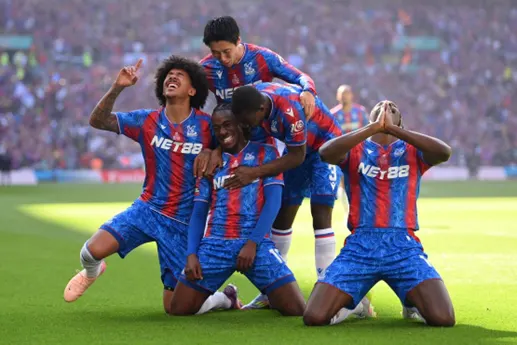
Individual quality matters; players like Eberechi Eze and Michael Olise (before their departure), and Marc Guehi provide the technical ability to execute Glasner’s vision. But it’s the system that amplifies their strengths while minimising weaknesses.
The Challenges Lurking Ahead
Of course, no run lasts forever, and Palace face genuine concerns moving forward. Squad depth remains an issue; fixture congestion and fatigue could stretch their resources beyond breaking point. One or two key injuries might expose vulnerabilities that haven’t yet been tested.
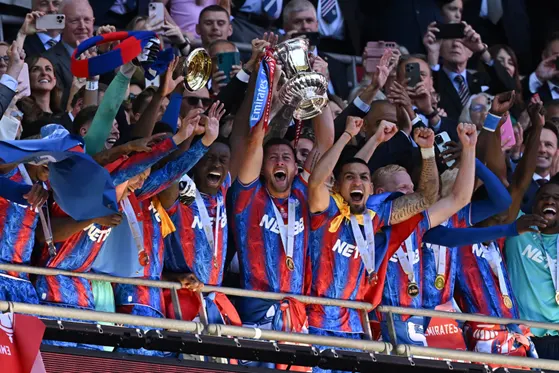
Adaptability presents another challenge. Remember how Nottingham Forest’s counter-attacking approach was eventually nullified late last season once opponents figured out their patterns? Can Glasner evolve his system when teams arrive at Selhurst Park specifically prepared to neutralise Palace’s direct speed?
How adaptable is your manager? How strong are the hamstrings?
A Blueprint for the Underdogs
What makes Palace’s story so compelling isn’t just the results- it’s the method. They’ve proven you don’t need possession dominance to control games. You don’t need the deepest pockets to compete with financial superpowers. What you need is a clear identity, total commitment to that identity, and the courage to execute it regardless of opposition.
Eighteen games unbeaten isn’t luck. It’s philosophy made manifest, tactical precision translated into points, and collective effort rewarded with success. Whether they can sustain it through the long grind of a full season remains to be seen, but right now, Crystal Palace are providing the blueprint for how well-organised underdogs can compete with and beat the elite.
And that’s what makes football beautiful: sometimes the theory works exactly as drawn up on the tactics board, and the whole damn thing clicks into place.

